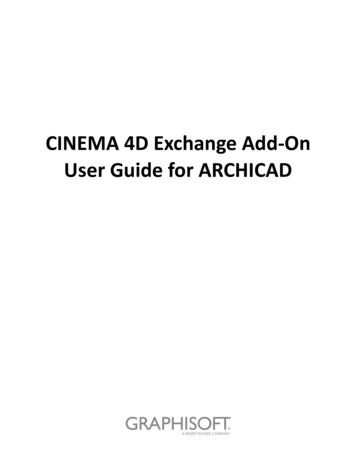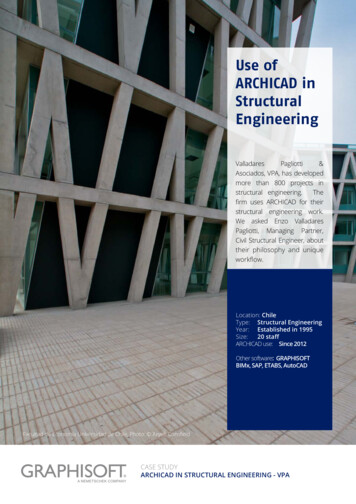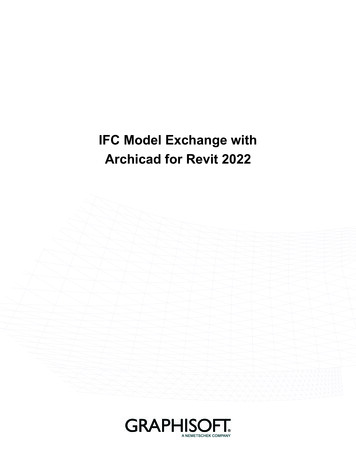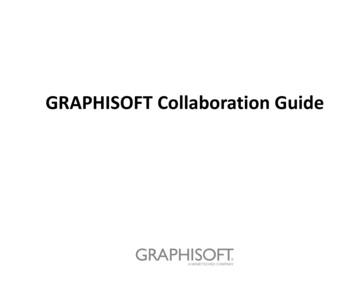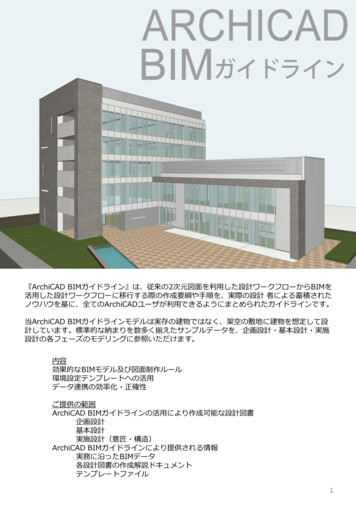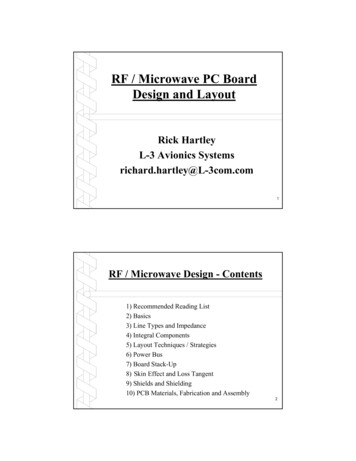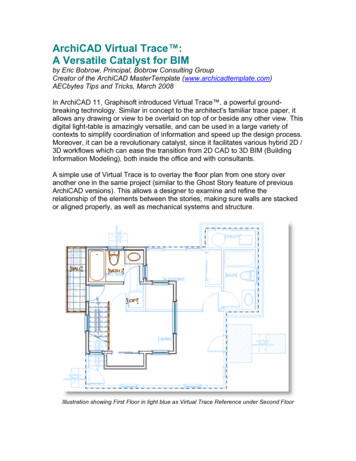
Transcription
ArchiCAD Virtual Trace :A Versatile Catalyst for BIMby Eric Bobrow, Principal, Bobrow Consulting GroupCreator of the ArchiCAD MasterTemplate (www.archicadtemplate.com)AECbytes Tips and Tricks, March 2008In ArchiCAD 11, Graphisoft introduced Virtual Trace , a powerful groundbreaking technology. Similar in concept to the architect's familiar trace paper, itallows any drawing or view to be overlaid on top of or beside any other view. Thisdigital light-table is amazingly versatile, and can be used in a large variety ofcontexts to simplify coordination of information and speed up the design process.Moreover, it can be a revolutionary catalyst, since it facilitates various hybrid 2D /3D workflows which can ease the transition from 2D CAD to 3D BIM (BuildingInformation Modeling), both inside the office and with consultants.A simple use of Virtual Trace is to overlay the floor plan from one story overanother one in the same project (similar to the Ghost Story feature of previousArchiCAD versions). This allows a designer to examine and refine therelationship of the elements between the stories, making sure walls are stackedor aligned properly, as well as mechanical systems and structure.Illustration showing First Floor in light blue as Virtual Trace Reference under Second Floor
However, Virtual Trace goes much further than Ghost Stories. For example, itallows an elevation or a section to be viewed next to a floor plan, or twoelevations or sections next to each other in the same window. This is far morepowerful than seeing these two related views in separate windows (as in all otherBIM applications), for one can use the reference as an editing aid to align, snap,measure or pick up settings from elements in the traced view.Plan view with Elevation as Trace Reference - note dashed Guidelines from Elevation drawinghelp to align elements from two different storiesOne can quickly switch back and forth to edit two related views, and see the floorplan immediately update when changing an elevation drawing. Working on a liveview of the project, such as a plan or elevation, one can see and coordinate withthe layout sheet on which it is placed. Virtual Trace makes it simple to aligndrawings on one sheet to corresponding drawings on another sheet.The dynamic Visual Compare features within the Virtual Trace palette give manyoptions for analyzing relationships and differences between two drawings,whether they are:
two related floor plans;earlier and later versions of a design;before and after views of a remodel; ora consultant's drawing being coordinated with the architect's work.Structural DWG as Trace Reference under Floor Plan - isolated in upper half with SplitterInteractively varying the opacity or placement of either drawing helps the eye tosee subtle relationships, as does the splitter which can slide across the screen toreveal one drawing against the other. Differences that might have been missedbecause of the complexity of graphic information are easily spotted and can beredlined or noted for action.Unlike some BIM programs, ArchiCAD has always allowed a flexible process,never insisting that "everything be done in 3D." Whenever desired, the 3D modelinformation can be manipulated in 2D to create beautiful, precisely controlleddrawings.With Virtual Trace, this hybrid workflow (in which the 3D model informs andcoordinates the 2D documents) is even more easily managed. This is arevolutionary catalyst that will allow firms of any size to transition at their ownpace from 2D CAD to 3D BIM.
Virtual Trace BasicsWe'll start with a basic introduction to activating and controlling Virtual Trace. Fora more detailed explanation of all the interface options, please refer to theArchiCAD 11 Reference Manual, pages 117 - 125.The simplest way to activate Virtual Trace is to right-click in the Project Map onthe desired Story, Section or Elevation and choose Show as Trace Reference.The Trace Reference may be controlled by commands in the Trace & Referencepopup menu located in the Toolbar:It is much easier to interactively control these features by using the Trace &Reference floating palette. As highlighted above, select Trace & Reference fromthe popup menu to open this elegant and compact palette.
Trace & Reference palette with explanationsWhen a Trace Reference is shown, it is seen inside the active editing window,with the contents under or beside those in the active view. While one may snapto or pick up settings from the Reference elements, they may not be selected oredited while being seen as a Trace. If you try to select or edit an element from atrace reference, a message will say "This element is inactive in this view."The colors of the Reference and Active elements can be set as desired usingpopup menus, either as single colors or using their original pen colors. Thesliders for the Reference and Active drawings change the opacity or visualdensity of the images. To simplify what is shown in the reference drawing forlegibility, use the popup in the middle of the right side to turn off categories suchas dimensions, text, or fills.The Trace can be turned off or on with a single click of the top left button, anddragged, rotated, returned to a default position or rebuilt (refreshed or updated)with buttons underneath the top popup menu that chooses among recentreference views. Clicking the Switch button near the top left will make the currentreference view active, and set the current active view to be the trace reference.The Visual Compare controls at the bottom of the palette simplify study of thetrace reference. One can move it temporarily aside, bring it on top of the activeelements, split the window with sliders that reveal one image against the other, ormake fills transparent to show elements otherwise hidden.
The best way to learn the effect of each of these controls is simply to try themout. They are quick (and even fun) to test, and easy to understand. In addition,Graphisoft has created some interesting video demonstrations of Virtual Trace /action/TIP: One can select a View from the View Map to act as a TraceReference, or select an entry in the Project Map. Be careful though - if youreference a View with different layers turned on than your active window,ArchiCAD will have to work harder to calculate and display two differentlayer "conditions", which may slow down your redraw and navigation.Whenever possible, choose a Reference from the Project Map, which willthen show that viewpoint using the same layers as the active window.Versatility GaloreThe applications for Virtual Trace are almost endless. In BCG's classes for usersupgrading to ArchiCAD 11, we regularly spend more than two hours exploringvarious ways that it can be used, without exhausting the possibilities.Here are some of the ways Virtual Trace can be applied: Overlaying one story against another to verify structural relationships, or tosnap and align new elements in relation to those on the traced storyShowing the site plan or a lower story as a light image underneath anotherfloor plan - this can be printed for study or presentationSeeing a plan overlaid with another view of the same story which hasdifferent layers turned on (such as cabinets, structure or landscaping)Developing a site plan in a 2D Worksheet while coordinating with thebuilding modelViewing and aligning elements to an elevation or section while working onthe floor plan (see below - note that the elevation will automatically rotateas needed to align next to the plan drawing)
Working on an elevation or section while studying the floor plan of any ofthe related stories (the floor plan will automatically rotate to align properlyto the elevation)
Drawing or modeling in one elevation or section while comparing,snapping or picking up settings from another elevation or section side byside (these will automatically align to each other vertically) Editing an elevation while seeing a section that is "further back" directlybehind it
Working on dimensioning or other annotation of a drawing while seeingthe sheet on which it is placed (along with other drawings on that layout),or with a blank sheet image to visualize how it will look on paper
Adjusting the placement of drawings on a layout while viewing anothersheet underneath (see illustration below of Roof Plan layout with FloorPlan sheet as reference in orange underneath) Editing a detail drawing while seeing the original context from which it iscalled out - see illustration below - this is particularly important if the modelhas been modified
Coordinating any enlarged 2D drawing (such as a restroom plan or a wallsection) in a Worksheet against the latest version of the "live" model fromwhich it was excerptedExamining a DWG file from a consultant to see how it relates to thearchitectural drawing, to shop drawings or to other consultantsReviewing one version of a drawing against an earlier oneComparing new designs versus the as-built or existing building (see below- Splitter reveals existing drawing as a trace reference, with "active" newaddition on left)
Maintaining consistency and accuracy of manually drawn or editedsections, elevations or interior elevations against the latest version of the3D model (see final section of this article for more comments on this)Picking up element settings with the eye-dropper from an interactivelegend of visual favorites shown as a trace beside the active working view(see illustration below from BCG's ArchiCAD MasterTemplate)
TIP: Each viewpoint in the Project Map will remember the last 5 TraceReferences that were used. These may be accessed from the popupmenu at the top of the Trace & Reference palette. Certain viewpoints areautomatically added to this list: for example, when viewing a plan, thereare choices for one story up, one story down, and previous story (the lastone you were looking at); when viewing an interior elevation, the otherinterior elevations in that room will be available for quick reference.Easing the Transition to BIM while Enhancing the WorkflowGraphisoft's Virtual Trace technology can actually revolutionize the workflow inan office, while simplifying the transition to Building Information Modeling. Now allteam members can participate actively in the BIM environment even if their skillsor focus are primarily 2D. In addition, drawings from consultants can becoordinated more easily without requiring them to jump to a full BIM process.Let's take a look at new possibilities in the workflow and relationships betweenteam members inside an office as well as between architect and consultant. Theimage below depicts four distinct roles, each of which could be played by morethan one person.
The Project Architect is of course the main designer and decision maker. In thisscenario, he is comfortable with creating the design in 3D as a BIM model.The first example involves the Design Workflow - in which the Project Architectis paired with a Designer who is much more proficient in 2D CAD than she is in3D BIM. In ArchiCAD, the Designer can effectively develop the floor plan in away quite similar to the traditional 2D CAD process, refining the space plan,program and detailing the structure. With Virtual Trace, she can easily see therelationship of the plan with the section as she makes changes (see imagebelow), without having to become a "power modeler."
Plan with area in "marquee" ready to be adjusted, seen with Section below as trace referenceVirtual Trace also improves the Coordination Workflow between the ProjectArchitect and the Consultant. In the next example image, the structural drawinghas been overlaid on top of the architectural plan, and the right-hand splitter haspulled back one drawing midway, to reveal plainly the differences next to doorD124. Notice how the walls in red from one drawing do not properly line up withthe walls in black from the other drawing. Even though the consultant may workin traditional 2D CAD, the DWG information can be coordinated effortlessly inArchiCAD's Virtual Building.
Virtual Trace also enhances the Documentation Workflow between the ProjectArchitect and the Draftsman, helping greatly in the creation of high qualitydocumentation. Virtual Trace allows you to keep the 3D model "live" forcoordination purposes even in the late phase of the detailed constructiondocumentation.In our final example, the model section remains "live" while the draftsman edits acopy of it to create the detailed section. If the design changes, for example thestory height needs to be changed, it is very easy to update the detailed sectionthrough coordination with the model. In this image, part of one drawing is pulledback with the splitter. Notice how the upper story does not match the revisedmodel, while the lower story still overlays cleanly.
The draftsman can edit the final section drawing in a 2D worksheet withouthaving to touch the model, while seeing and aligning precisely with the model asa trace reference.Graphisoft has prepared a fascinating short video clip that vividly illustrates theseexamples, and their potential impact on the roles and workflow in an architecturaloffice. Please visit http://www.graphisoft.com/products/archicad/ac11/ and clickon the graphic link near the top of the page "Virtual Building & Virtual Trace."The Bottom LineVirtual Trace enables a workflow that combines the benefits of the VirtualBuilding with the flexibility required to create the detailed documentation ofcomplex projects. It helps a firm involve every member of the project team inBIM, from the designer to the draftsman, utilizing their existing skill sets. Itimproves the design workflow and productivity, and helps to deliver bettercoordinated projects at the same time.Virtual Trace is a unique and revolutionary technology created by Graphisoft inArchiCAD 11. It reaches into almost every part of the design, documentation andcoordination process. It is a fine example of how Graphisoft takes traditionalconcepts (in this case, tracing paper) and reinterprets and reinvents them toredefine the state of the art. The pioneer of Virtual Building, the first BuildingInformation Model software, keeps pushing the limits!To give me feedback or ask questions about this article, please send an email toarticle@bobrow.com. I look forward to hearing from you!About the Author
Eric Bobrow, Principal of ArchiCAD reseller Bobrow ConsultingGroup (BCG), has been using ArchiCAD and training architectssince 1989. BCG is a Graphisoft Platinum VAR based in LosAngeles and San Rafael CA that for a decade has ranked as oneof the top 5 U.S. resellers. BCG is the creator of the ArchiCADMasterTemplate, a robust project startup kit for ArchiCAD users for more info, visit www.archicadtemplate.com.
ArchiCAD Virtual Trace : A Versatile Catalyst for BIM by Eric Bobrow, Principal, Bobrow Consulting Group . In ArchiCAD 11, Graphisoft introduced Virtual Trace , a powerful ground-breaking technology. Similar in concept to the architect's familiar trace paper, it allows any drawing or view to be overlaid on top of or beside any other view .



